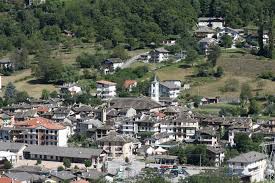Italy town offers foreigners $10,000 to move there

Rome: One town in Italy is offering foreigners $10,000 to move there. Another says it will even pay newcomers more than $1,000 per child to make babies.
The deals may seem too good to be true for many who dream of escaping the rat race for the idyll of a rustic Italian village. For the destinations involved, they represent a last-ditch battle to save the souls of their dying communities.
But it’s complicated — this is a country where local property regulations are often tangled up in byzantine legalities.
And, of course, it’s a place where attitudes towards foreign incomers are sometimes ambivalent, as highlighted by a recent rise in political hostility towards economic migrants arriving from Africa and the Middle East.
The latest deal to beat them all comes from Giovanni Bruno Mattiet, the mayor of the tiny Alpine village of Locana, in Piedmont, the mountainous northwestern region of Italy that borders France and Switzerland.
He’s willing to pay up to €9,000, or $10,200, over three years to families willing to move in and take up residency amid snowy peaks and flower-strewn pastures, as long as they have a child and a minimum annual salary of €6,000.
“Our population has shrunk from 7,000 residents in the early 1900s to barely 1,500 as people left looking for a job at Turin’s big factories,” Mattiet said. “Our school each year faces the risk of shutting down due to few pupils. I can’t allow this to happen.
In Locana each year there are 40 deaths versus just 10 births. It’s a familiar picture across Italy where, in the last 30 years, one in four small communities have become ghost towns. There are now 139 villages with fewer than 150 residents.
And while Mattiet’s deal was initially offered just to Italians or foreigners already living in Italy, he’s now so desperate to save his town from dying, he’s extending it to non-Italians abroad too.
“We’re looking to draw mostly young people and professionals who work remotely or are willing to start an activity here,” he says. “There are dozens of closed shops, bars, restaurants and boutiques just waiting for new people to run them.”
The town may be small but it’s wealthy, thanks to the clean hydroelectric energy it sells to Italy’s state.
With the money comes a great location. Locana’s territory spreads across 132 square kilometers of the Gran Paradiso mountain reserve, offering fresh air and outdoor activities like ice-skating fishing, trekking, rock climbing, swimming, soccer and tennis.
Picturesque Alpine dwellings are made of stone and wood with typical pointed tile roofs and frescoed walls adorned with flowers. Old bridges cross clear streams.
The valleys are dotted with chestnut forests, solitary chapels, abandoned lodges, dairy farms, mills and copper mines in need of a restyle. Two minuscule ghost hamlets are accessible by foot only on mule paths covered by overgrown cherry shrubs.
“Locana offers a healthy lifestyle, great food and folklore fairs all-year round”, says Mattiet.
Locana isn’t the only town in Piedmont badly in need of a rebirth. A little farther north, on the Swiss frontier, the mayor of Borgomezzavalle is playing what he hopes will be a winning card.
To revitalize a population that’s dwindled to barely 320 residents, Alberto Preioni is not only selling abandoned mountain cottages for just €1 — just over $1 — he’s also paying all newcomers who are starting a family.
“This town was created in 2016 with the fusion of two neighboring villages which were disappearing,” he said. “We’ve got tons of money to invest but we need kids and youth.
“That’s why I’m offering €1,000 for each newborn and another €2,000 to anyone willing to start a business and register for VAT.”
Local taxes are very low and Preioni also promises free public transport to all students. There’s not even any need to take up residency.
Borgomezzavalle — the name means “the town between the valley” — is stuck inside a canyon, but there’s sunlight all day thanks to a huge mirror placed on the opposite hillside that reflects the rays.
Brightly colored houses with thatched roofs, carved from the mountain flank, are clustered around neat cobbled piazzas with wooden benches and flower pots.
Narrow winding alleys lead to frescoed arcaded porches with decorated columns and lavish palazzos featuring loggias.
The €1 buildings on sale include crumbling wood and stone cottages, barns, stables and former farm and artisan dwellings. The only catch is that the new owners must commit to refurbishing the houses within two years.
“I invite anyone interested to come see what a peaceful place this is, our untouched nature offers a detox and unplugged stay far from the madding crowd”, says Preioni, who’s also recovering abandoned agricultural lands for use by would-be farmers.
Borgomezzavalle and Locana are just the latest in a series of towns in Italy offering cheap, dilapidated properties to foreigners or paying them to move there (and take note, it’s intended to be a permanent move, not just the offer of a cheap vacation home).
Extremely low taxes, great life quality, cheap services and rentals have successfully turned many dying spots into havens for foreign retirees.
In the Sicilian towns of Partanna, Caltabellotta, Giuliana, Siculiana and Cianciana renting a 50-square-meter apartment costs just €150 per month, while breakfast at the bar with local pastry specialties is €2.
If this all sounds too good to be true — well it is and it isn’t. Andrea Ungari, contemporary history professor at Rome’s top LUISS University, says shoring up communities with an influx of foreigners will fail to address the issues that caused people to desert the towns in the first place.
“It’s OK in the short run, foreigners love Italy’s beauty and crave for an eternal holiday in a sunny spot,” he says. “But in the long run, even they need upgraded infrastructures, good and nearby hospitals, efficient services, especially retirees.
“You need a long-term plan to develop the local territory and keep people there.”
One solution might be to populate the dying towns with the migrants who flock to Italy on boats across the Mediterranean, fleeing peril or hardship in Africa or the Middle East. Indeed some have moved into places like Riace, in the southwest Calabria region or Val Camonica in northern Lombardy.
It’s a strategy unlikely to gain traction in Italy’s current political climate though. The country’s new coalition government, particularly the populist League party of Deputy Prime Minister Matteo Salvini, has spoken out against hosting migrants in Italian villages.
In two shrinking towns — Ollolai and Candela — the deals aimed at attracting more economically attractive foreigners seem to be working out well.
Candela, in southern Puglia, offered people up to €2,000 to move there plus tax credits. It now boasts a dozen new residents of all ages, nationalities and professions, says former mayor Nicola Gatta.
In just over a year Ollolai, on the island of Sardinia, has sold several dozen €1 houses that have already been refurbished. Six are currently being restyled while another 20 will soon be handed over to new owners.
Foreign newcomers are mostly young professionals who work remotely or retirees, but there are also Italians who have returned to their hometowns.
“We weren’t expecting such a success, with people coming from Europe, the US, Brazil and Australia as our new next door neighbors”, says Ollolai’s deputy mayor Michele Cadeddu.
Fashion designer Marije Graafsma, who sold her home in the most northerly part of the Netherlands to relocate to Ollolai together with her partner, is enthusiastic about the move.
“It’s great, I’m so happy,” she says. “We’re almost done restyling our lovely house with a fantastic view of Sardinia’s wilderness. We can’t wait to settle in for good.
“In Holland people are always on the run, they don’t talk much. Here they’re welcoming, very friendly, you get offered coffee and treats. We feel part of a big family.”
Graafsma has spent €75,000 on rehabilitating her attractive new dwelling. It’s a good price compared to average property costs in Italy.
She says she didn’t mind having to deal with a bit of red tape given she was “prepared for it” and the local mayor’s office helped with the paperwork.
Bureaucracy can be hell in Italy — but some say it’s worth it.
In the Sicilian town of Gangi, where 200 crumbling €1 euro dwellings have been sold mainly to European professionals and artists, it took Danish computer science engineer Torkel Jensen almost two years to jump through all the necessary administrative hoops.
“That’s OK, I knew what I was in for,” he says. “But finally, now, this lovely house, 150 square meters, is our new home. I used to live between Sweden and Denmark, so cold and dark, we wanted a sunny place”, he says.
“Here it’s gorgeous and warm, people are so nice and open. My wife and I will be spending six months a year, hopefully more. I’ve retired but keep working remotely”.
Jensen has spent about €100,000 on an elegant renovation. While basic building materials are cheap, specific items can be more expensive. “Still a great deal, though,” he adds. But, says Jensen, there’s another issue to consider for families.
“These towns are great for retirees and couples without kids. For children it’s not so great if you plan to live here all year-round.”
While a few copycat towns have been unsuccessful in the endeavor due to real obstacles others have turned out to be empty gimmicks or too complicated to sustain.
Bormida, in the northwest Liguria region that adjoins France, rescinded its offer to pay people to move there when its mayor admitted he was just trying to draw attention.
Montieri in Tuscany initially advertised €1 homes but then placed them on the market for prices starting at €20,000.
The mayors of Carrega Ligure in Piedmont and Lecce nei Marsi in central Abruzzo tried hard to get their own deals off the ground but were thwarted by red tape, Italy’s hellish property restrictions and bickering between family members over who owned old houses.
“It was impossible to track down and convince all the originals owners of the crumbling ruins, most had migrated in the 1940s, says Guido Gozzano, the former mayor of Carrega Ligure. “And even when we did, the state wouldn’t allow us to dispose of the land where the dwelling was built on. “In the end, I gave up.”





